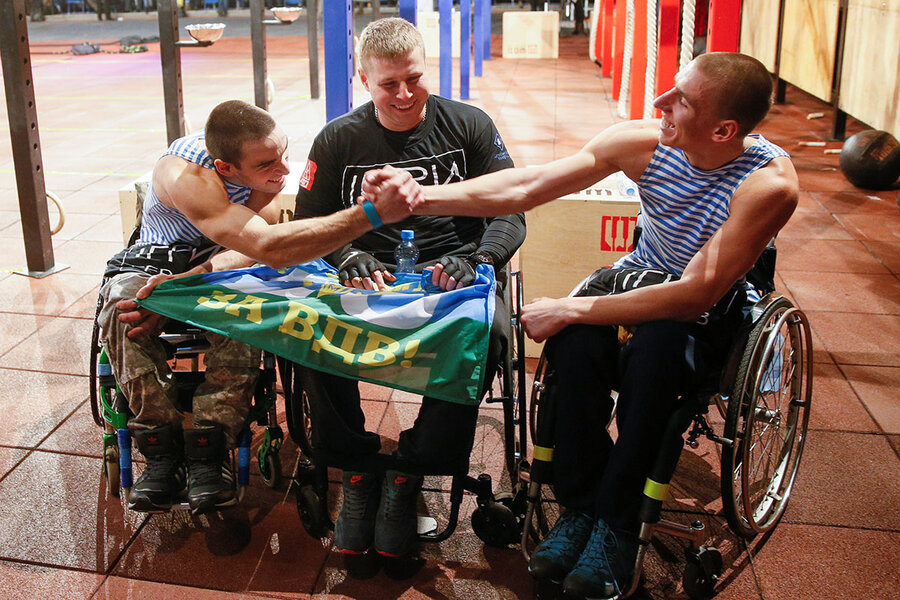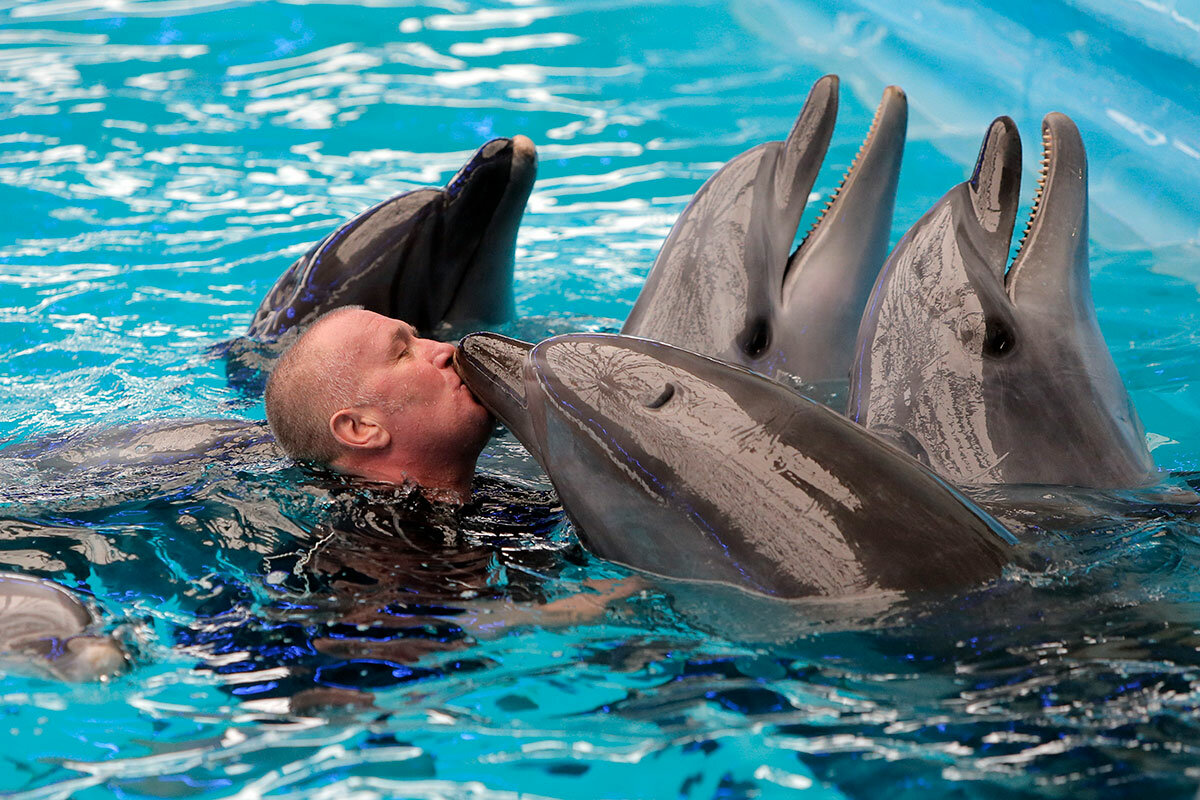Wounded vets force disability rethink in Ukraine
Loading...
| Kiev, Ukraine; and Washington
As he approaches the finish line of the Marine Corps 10K race, Vadym Svyrydenko breaks into a broad smile: He has picked out the blue and yellow of his country’s national flag amongst the red, white, and blue.
Mr. Svyrydenko, a Ukrainian, stands out, too. He’s running on “blade” prosthetics, having lost parts of both arms and both legs while fighting Russian-backed separatist forces in 2015. Back home he is spearheading a campaign to bring people with disabilities out of the shadows where they have long been hidden, and to help them carve out new lives.
He has chosen sport as the best way to do this. “We are getting more boys who were severely wounded and are showing them that rehabilitation through sport is effective,” the 44-year-old former soldier says as he recovers from his race. And Ukrainian veterans’ success in international athletics competitions has captured the nation’s imagination, removing some of the stigma from physical disability.
As Ukraine enters its fourth year of war, the growing number of wounded veterans returning from the frontlines is forcing the country to upgrade its rehabilitation programs, and to look afresh at how it treats people with disabilities in an urban landscape that is still largely Soviet.
“It’s good if attention turns to this issue not just for the people who were injured in the war, the wounded warriors … but also for people who were born with disabilities,” says Pavlo Mamontov, a former soldier who overcame his combat injuries to win a bronze medal in rowing at September’s Invictus Games, an international competition for veterans. “It’s cool that we can help others, not just ourselves with these competitions.”
Ukraine’s team of men and women veterans won 14 medals in at the Toronto Invictus Games, a multisports competition open to injured serving military and veterans created by Britain’s Prince Harry, himself a former British Army officer. Their success drew wide press coverage at home, and some veteran sportsmen have become minor media stars in Kyiv.
From taboo to fashion plate
The phenomenon has drawn closer attention to people with disabilities. Earlier this year a glossy magazine devoted an unprecedented amount of space to fashionable portraits of veterans, each missing one or more limbs. The national online investigative newspaper Ukrainskay Pravda recently published an article about what daily life is like for popular TV news anchor Ulyana Pcholkina and her partner, who both use wheelchairs. Characters with disabilities have also started appearing on TV drama shows.
This is all a stark departure from Soviet times, when people with disabilities were “taboo and highly stigmatized,” says Sarah Phillips, a professor at Indiana University in Bloomington who has authored a book on disability rights in Ukraine. In those days, she recalls, parents were encouraged to institutionalize their children out of public sight. “There was a lot of denial that problems of disability even existed in Soviet society.”
Now, very visible veterans are coming back from the front, and last year Svyrydenko was appointed President Petro Poroshenko’s commissioner for the rehabilitation of men and women wounded in the war. That allows him to advocate for veterans’ needs, such as modern rehabilitation centers, greater funding for prosthetics, and an increase in the number of medical specialists.
Though the government last month extended disability rights laws to war veterans, a presidential decree ordering more rehabilitation centers for people with disabilities has yet to be fulfilled. One such center, in the Carpathian mountains, teaches veterans and civilians how to build new lives. Lviv’s military hospital became the country’s first to have an occupational therapy kitchen, and the cities of Kyiv and Kharkiv both host prosthetics centers. But such facilities are scarce.
Ukraine ratified the UN’s Convention on the Rights of People with Disabilities in 2009, but a report by the Coalition of Organizations of People with Disabilities in 2011 found that only 30 percent of people who needed rehabilitation and transport equipment actually had it. The same group found last year that public transport remains a problem.
Access “is still an acute question,” says Svyrydenko, and local officials bristle defensively when he brings the issue up. But he keeps pushing, and encourages veterans to take municipal administrators with them on tours of their cities, to see what life is like in a wheelchair. “The system needs to be disrupted and we are disrupting it,” Svyrydenko declares.
Meanwhile, the national education system is adapting, and medical schools are stepping up courses in physical and occupational therapy. The problem says Renata Roman, a Canadian physical therapist who has been volunteering for more than 20 years in Ukraine, is that “the profession of occupational therapy does not exist per se” yet in Ukraine.
A journey has begun
However slowly, though, the situation for people with disabilities in Ukraine is changing. Yaroslav Hrybalskyy, chairman of the Lviv branch of the Rehabilitation of Disabled People, a local nongovernmental organization, is happily surprised, for example, to find that he can get into the cafe where we meet, even though he uses a wheelchair.
And Mr. Mamontov, the Invictus rowing medallist, is planning with his wife to open a cafe in Kyiv with a social mission that will employ people with disabilities and older pensioners who have difficulty finding jobs.
High-profile sporting events and their attendant media coverage cannot disguise how far there is to go before the average Ukrainian fully accepts people with disabilities, or before society fully takes their needs into account, says Professor Philips. But the journey has begun. “I have seen an opening up of people’s hearts and minds in terms of thinking about this type of difference and having true concern for … equal rights and disabilities,” she says.
As for Svyrydenko, sweating at the end of his 71-minute 10K, he says that he runs in memory of his dead comrades, but also to encourage those who survived their injuries and now find themselves in hospital. He does it, he explains, “for them to see that through sports you can continue to pick yourself up physically, psychologically, and this is necessary to do. It’s not easy for us to do, either, but we do it so it can be an example.”







